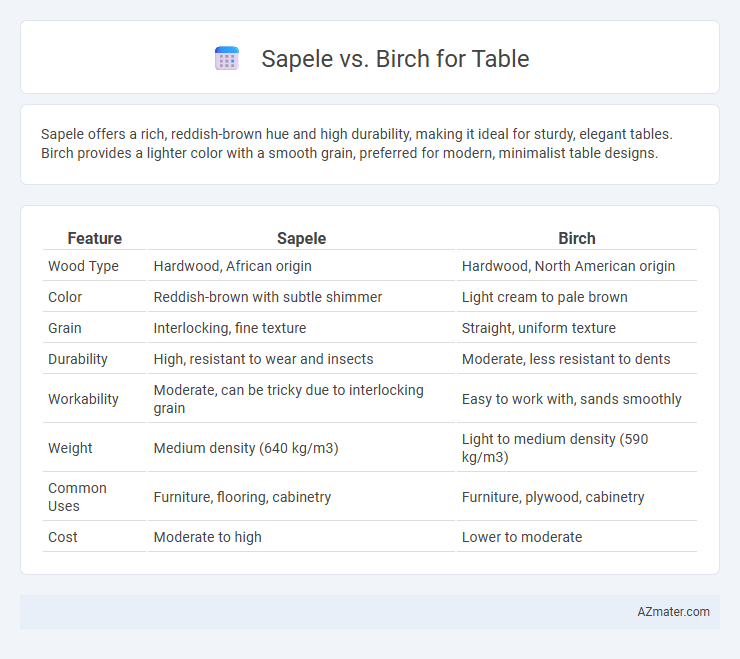Sapele offers a rich, reddish-brown hue and high durability, making it ideal for sturdy, elegant tables. Birch provides a lighter color with a smooth grain, preferred for modern, minimalist table designs.
Table of Comparison
| Feature | Sapele | Birch |
|---|---|---|
| Wood Type | Hardwood, African origin | Hardwood, North American origin |
| Color | Reddish-brown with subtle shimmer | Light cream to pale brown |
| Grain | Interlocking, fine texture | Straight, uniform texture |
| Durability | High, resistant to wear and insects | Moderate, less resistant to dents |
| Workability | Moderate, can be tricky due to interlocking grain | Easy to work with, sands smoothly |
| Weight | Medium density (640 kg/m3) | Light to medium density (590 kg/m3) |
| Common Uses | Furniture, flooring, cabinetry | Furniture, plywood, cabinetry |
| Cost | Moderate to high | Lower to moderate |
Introduction to Sapele and Birch Woods
Sapele, a hardwood native to West Africa, is prized for its rich reddish-brown color and fine grain, making it a popular choice for elegant furniture and tabletops. Birch, sourced primarily from North America and Europe, features a pale cream to light reddish-brown hue with a smooth, even texture ideal for modern and minimalist table designs. Both woods offer durability and workability, but Sapele's distinctive aesthetics and natural luster often appeal to high-end craftsmanship, while Birch provides a versatile, cost-effective option for functional yet stylish tables.
Wood Appearance: Sapele vs Birch
Sapele wood features a rich reddish-brown color with a fine, interlocking grain that adds a striking visual texture to tabletops, while Birch displays a pale cream to light yellow hue with a smooth, straight grain offering a more uniform and subtle appearance. The striking contrast in Sapele's darker, glossy finish makes it ideal for statement furniture pieces, whereas Birch's light tone suits designs emphasizing brightness and simplicity. Both woods provide excellent surface smoothness, but Sapele's natural luster and unique grain patterns deliver a more distinctive and exotic look compared to Birch's classic, understated appeal.
Durability and Hardness Comparison
Sapele wood, known for its high durability and natural resistance to decay, offers a Janka hardness rating of approximately 1,410, making it suitable for long-lasting tables in moderate to high-traffic environments. Birch, with a slightly lower Janka hardness around 1,260, provides good wear resistance but is less durable against moisture and impact compared to Sapele. For table construction, Sapele's superior hardness and durability make it a preferred choice where longevity and resistance to dents and scratches are critical.
Workability and Ease of Carpentry
Sapele wood offers smooth machining and excellent sanding properties, making it highly suitable for intricate table designs, while its interlocked grain can pose slight challenges in planing. Birch is known for its fine, even texture and uniform grain, allowing effortless cutting, shaping, and finishing during table construction. Both woods provide good workability, but birch tends to be easier for novice carpenters due to its consistent grain and lower risk of tear-out.
Cost and Availability Factors
Sapele wood is generally more expensive than birch due to its exotic origin and limited availability in certain regions, which affects overall project costs for tables. Birch is widely available in North America and Europe, making it a more cost-effective option for furniture makers and consumers. Both woods offer durability, but budget-conscious buyers often prefer birch for its affordability and consistent supply.
Environmental Impact and Sustainability
Sapele originates primarily from West African forests and its harvesting often raises concerns about deforestation and biodiversity loss due to less regulated logging practices. Birch, commonly sourced from North American or European plantations, benefits from sustainable forestry certifications that ensure responsible management and lower ecological footprints. Choosing birch for tables supports better forest regeneration and reduced environmental impact compared to Sapele.
Finishing and Staining Qualities
Sapele wood offers a smooth, consistent grain that absorbs finishes evenly, producing a rich, reddish-brown color ideal for elegant table surfaces. Birch provides a finer, closed grain that takes stains well but may require pre-treatment to avoid blotchiness and achieve uniform coloration. Both woods respond well to various finishing techniques, but Sapele's natural luster reduces the need for heavy staining, while Birch's light tone offers versatility for custom stains and finishes.
Maintenance Requirements for Tables
Sapele wood requires moderate maintenance due to its natural oils, which provide a degree of resistance to moisture and wear, making it suitable for tables with regular use. Birch, being a hardwood with a tighter grain, demands more frequent sealing or finishing to protect against stains and scratches in table applications. Both woods benefit from routine cleaning with a damp cloth and periodic application of wood polish or oil to maintain their appearance and durability.
Pros and Cons of Sapele Tables
Sapele tables offer a rich, reddish-brown hue with a smooth, interlocking grain that provides excellent durability and resistance to wear, making them ideal for high-traffic areas. The wood's natural resistance to rot and insect attacks contributes to long-lasting furniture, though it can be harder to work with due to its density and occasional brittleness. Compared to birch, sapele requires more maintenance to preserve its deep color but outperforms in terms of hardness and visual appeal, especially in traditional or luxury table designs.
Pros and Cons of Birch Tables
Birch tables offer a smooth, fine grain and light color that enhances various interior styles, making them a versatile choice for furniture. The wood's durability and resistance to dents provide long-lasting surface quality, but it is prone to yellowing over time and may require more frequent maintenance to preserve its appearance. While birch is generally more affordable and easier to work with than exotic hardwoods like Sapele, it lacks the deep, rich reddish-brown hues and natural luster that Sapele tables provide.

Infographic: Sapele vs Birch for Table
 azmater.com
azmater.com